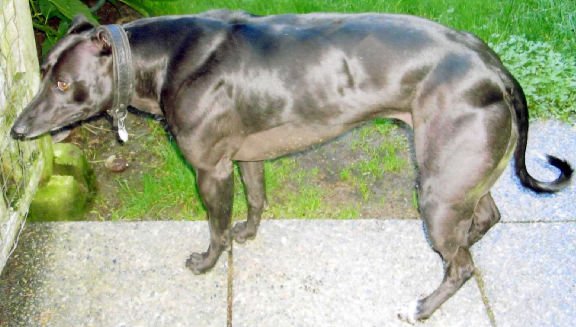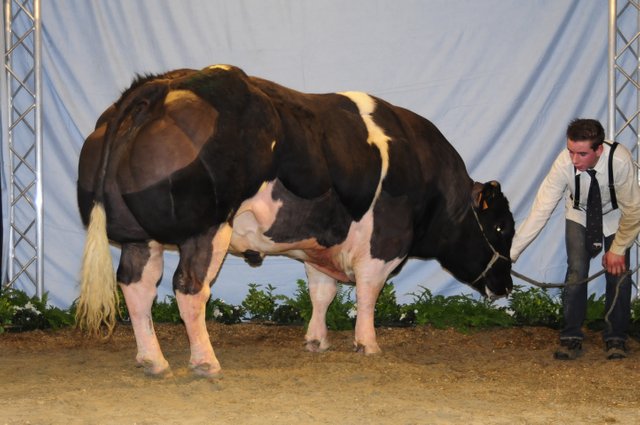The dog breed whippet can have a mutation in the genes that code for production of myostatin, resulting in the dogs having a huge muscle mass compared to other dogs from the same breed!
A few months ago I was trying to figure out which dog breed would be best for my family, and those of you who have followed my blog probably knows that we ended up with a whippet – a type of sighthound that looks a lot like a greyhound. However, during the research phase I came across a very interesting thing about the whippets, so today we will be looking at how genetics can make the whippets look like they have been eating steroids like it was dog treats!

The whippets are generally very slim, but just look at this “bully whippet”, and you can immediately see that there’s something different with him. Image by by Dana S. Mosher, Pascale Quignon, Carlos D. Bustamante, Nathan B. Sutter, Cathryn S. Mellersh, Heidi G. Parker, and Elaine A. Ostrander, published with the Creative Commons Attribution 2.5 Generic license.
As you can see from the image above, the muscle mass of this animal is obviously way higher than what you would expect, and it all has to do with a mutation in genes that control the muscle growth.
The genetics behind the bully whippet mutation
The protein in question is called myostatin, and is a member of the moykines – the proteins responsible for changes in the metabolism when an individual is exercising. Myostatin is pretty much responsible for inhibiting muscle growth so that we don’t keep growing our muscles forever after exercising. The protein is produced by the myostatin gene (MSTN), and if anything were to happen to this gene, the muscle production would be changed.
Animals have responded differently to mutations or deliberate changes in the MSTN genes, but most tend to get extremely muscular. This is exactly what happens with the whippet, and individuals who have mutations in both sets of the genes (remember that they get one set from each parent) will look like they are on steroids, and are called bully whippets.
The bully whippets will not only have more muscles, they also got a bigger tail, a broader head, shorter legs, and a pronounced overbite. They don’t really look like regular whippets at all to me, and if you compare the image at the top of the post to the one below this text, then I’m sure you can agree.

What a regular whippet looks like. Image by Ellen Levy Finch, posted with the Creative Commons Attribution-Share Alike 3.0 Unported license.
How the whippets ended up with the “bully whippet” mutation
I don’t think most people think that the bully whippets look very aesthetically pleasing, so why have we kept on breeding the dogs whom had a single variant of the mutated gene? If we just stopped breeding on all of these, the bully whippet phenotype variant would be gone from the gene pool rather quickly, but there’s actually a logical reason why it has stuck around.
Like the greyhounds, whippets are also used as racing dogs, and can reach a velocity of 55km/h at its peak. They are not as popular to use for racing as the greyhounds, but there are still a lot of whippet racers out there, and this is where the mutation comes into play. The whippets who carry a single mutation of the gene are not only more muscular than the regular whippets, they are also significantly faster!
This pretty much means that they are much more likely to win races, and are therefore much more sought after by breeders who want to breed even faster dogs. It seems likely that a single dog once got this mutation and ended up winning a lot of races, leading to many offspring. The offspring who inherited the mutation would then most likely be very good runners, and also be used for breeding, and after a few generations the mutation is common in the gene pool.
For those who want a more advanced look at the mutation, here you go: The mutation in MSTN is a deletion in the third exon, which leads to a stop codon at amino acid 313 (the full length is 375 amino acids). When a single base pair is deleted, all the following genes will be misread by the ribosomes that read the RNA, since each amino acid is coded by a set of three bases.
There are three different stop codons, and if either of these (UAG, UAA, or UGA) are transcribed, the protein synthesis in terminated. This leads to the protein being prematurely finished, and in this case non-functional.
If the two last paragraphs didn’t make a lot of sense to you, but still sounded interesting, then I picking up a book about genetics, or reading the Wiki page about the genetic code. It's really interesting stuff if you have the patience to get into it!
Mendelian genetics of the bully whippet
If you end up breeding two dogs who both carry one set of the mutated gene, then one quarter of the litter will end up as bully whippets, half of them having a single set of the mutated gene, and one quarter of them won’t carry any mutated myostatin genes. This is pretty basic Mendelian genetics, so go read about that if you want to learn more about inheritance.
Anyway, bully whippets have way too much muscles, making them useless for racing. Luckily they have not had any reported negative side effects of the mutation except for muscle cramps, but that would also be because of a small sample size, so you might not want to go ahead and get yourself a bully whippet.
Get yourself a regular whippet instead. They’re pretty great! Image by @valth.
Other animals with the mutation
Whippets are not the only animals that can have this mutation, although it’s the only dog breed who have this mutation in the gene pool. The most famous example of a double set of mutation in this gene is from the cattle breed Belgian Blue, which are used for producing meat.

A Belgian Blue bull. Image by Flickr user agriflanders, posted with the Creative Commons Attribution 2.0 Generic license.
Belgian Blues and whippets are the only two animals that have this mutation in the regular gene pool, but scientists have been using CRISPR/Cas9 to inhibit the gene in other animals as well. Recently scientists inhibited it in both goats and rabbits, and both of these became more muscular after the inhibition. Some scientists believe that this gene and protein could be important in developing drugs or other treatments for muscle diseases such as muscular dystrophy, but we’re still far away from this.
Thanks for reading
I hope you found this post interesting, because I know I did! It was really cool to stumble upon this mutation when researching which dog breed to get, and I’m pretty sure that Wilma does not have it since I met both parents, and they did not look like they had a lot of muscles. But thanks for stopping by!
Most of the information about the MSTN mutation in whippets is from the scientific article "A Mutation in the Myostatin Gene Increases Muscle Mass and Enhances Racing Performance in Heterozygote Dogs" by Dana Mosher et al. The other sources are found directly in the text where they are relevant.
About @valth
Hey, I'm @valth - the author of this post. I love to write about nature, biology, animals, nature conservation, ecology and other related branches of science, and I occasionally write about my life, about Steem or about random stuff as well. I'm trying my best to write at least one post every day, so make sure to give me a follow if you enjoy my content and want to see more of it.
Join the @valth community!
I love nothing more than to engage with my readers, so please join the @valth community in the comment section. You will definitely find more information about the topic, personal experiences, questions, and even opposing views down there, so don't miss out on learning more.
I always reward users who post good comments, so please take the opportunity to share your views and get a small upvote in exchange for it.
This is a very nice post and I don't want to interject a negative tone, but can't help noting that the bull seems to be in a body that can't be comfortable. I looked up a few things about Belgian Blues and see that in many instances they cannot reproduce naturally, but need repeated cesarean sections--also reproduction cycle is more rapid than usual, so they are subject to these operations frequently. Calves may suffer swollen tongues at birth and suffocate. It just doesn't seem to be an ethical proposition, perpetuating a mutation that will bring about such suffering. I know animal husbandry is a business and people eat meat. I just think we have a responsibility to obtain that meat in a way that brings the least amount of suffering to the food source.
I hope you forgive this serious interjection into your lovely blog about a dog. Dogs bring me joy and I liked looking at your pictures.
Don't feel bad about bringing this up, @agmoore. I totally agree with you, and it's far from ethical to raise Belgian Blue bulls for meat in my opinion. I do not endorse the use of this mutation for profit in any way, and I should probably have made that clearer in the post text itself.
I know you respect animals, so I'm not surprised :)
I was thinking something similar while reading this, maybe something like this can one day make steroids useless?
For a lot of people it would be great to naturally grow muscles while having zero side effects.
Yeah, that's what we are all wishing. It seems like the research into this type of treatment is still in its very early stages, so I have no idea if it's a real, viable replacement, but it is surely something that could be a good alternative.
Well the good thing about those bully whippets is they'd stop a home invader in their tracks and possibly make them backpedal the hell out not quite knowing what they've encountered XD Whippets in general are pretty adorable. Even the bully ones XD
I love genetics, wish I'd been a bit more normal-brained so I could have done that course at uni!
Hehe, yeah, a bully whippet is definitely going to make the home invaders disappear. I think the bully whippets also look pretty adorable, but the uncertainty of the health risks associated with the mutation is is big problem if I were to get one.
Genetics is a lot of fun, and it was definitely one of the courses I enjoyed the most at university. It can be a bit of information overload (at least for me) though, since there's a lot of different stuff to remember.
I have read somewhere that Nazi were trying to do the same genetic mutation to produce super soldiers... But they never succeeded...I don't know if it actually true or just stories.
But one thing is true that Nazis were into human experimentation.
I wonder with today's gene technology, is it possible to produce super soldiers...
That's interesting! Now I need to google that to find out more about it. I'm not sure a strong mutant human would make such a big different in the WWII anyway, considering that most soldiers had rifles and guns, but the nazis did do some crazy stuff anyway..
I think super soldiers could become a reality within a decade or two (or maybe a bit longer), at least when it comes to technology. The question is "should we?" in my opinion. There's a lot of ethical problems with creating genetically engineered soldiers.
You are right about ethics, but I am afraid that the war machinery does not car about ethics..
That's definitely true.
It was very interesting.
I learned a lot for myself.
Thanks, @valth for the new knowledge.
I Love dogs, especially such. They have a high hunting instinct and they can rush off for prey, forgetting about everything.
There were times when such breeds were crossed with Terriers.
I think that among them was Bedlington Terrier, which is distinguished by its long legs.
But you already guessed...
That this breed I like more than others - I always know her )
I've never heard of the Bedlington terrier, but wow, they are adorable! They almost look like a small sheep. And I'm glad you liked the post, and thanks for stopping by, @singa!
This breed was bred in the 18th century in the
East of England in the town of Bedlington,
after which the Pets and got its name.
The animals were bred as a rescue from rodents
and pests that densely populated the mine and
brought a lot of problems to its employees.
Oh, that's a cool story about them. I have never seen one in real life, but now I want to do just that!
Too bad CRISPER hasn't come up with a way to take this mutation and apply it to my skinny ass!
Thanks for the informative post.
Namaste, JaiChai
Hehe, we're still a long way from that point. Or maybe not that long.. Maybe you will be able to do this soon.
Science is progressing day by day.we are having many changes through biotechnology in plants..these animals are great success which scientists are getting through mutation.hope they will help soon in muscle diseases.
Yeah, genetic engineering definitely has the potential to cure or treat muscle diseases in the future. It will be interesting to see if these genes and proteins will be a part of the solution.
Just to clarify
Myostatin mutations have been found in humans:

https://www.nejm.org/doi/full/10.1056/NEJMoa040933
It was the previous work on the myostatin knockout mouse that lead the doctors to investigate if the muscle baby had a mutation in the myostatin gene: http://www.pnas.org/content/98/16/9306
That's true, but we don't really have it commonly in our gene pool. Maybe it will happen when this baby grows up and starts reproducing, but as of right now there's no need to worry about having this mutation.
You always shares something unique and different about animals.
So today i came to know something new about Bully Whippet.
I'm glad you learned something new today ;)
Awesome photography @valth. I like dogs as a pet that all knows about they are faithful. Amazing picture of dog. Nice capture.
Thanks for sharing this post.
Have a wonderful day! 🤗
Thanks. Have a wonderful day yourself :)